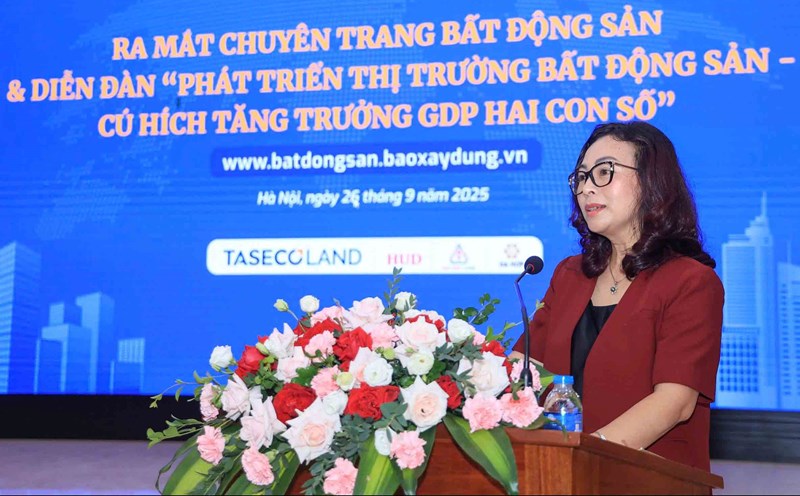Real estate business recovers, contributing to GDP
As reported by Lao Dong Newspaper, in the first 6 months of 2025, credit capital continued to flow strongly into real estate. The value of collateral assets such as houses and land at most commercial banks increased compared to the end of 2024, accounting for a large proportion of total mortgaged assets.
At the same time, outstanding loans related to the real estate sector have also expanded, ranging from business activities, construction to consumption associated with housing.
This picture reflects the growing role of real estate in the credit system, but also raises concerns about the level of dependence and the risk of focusing on a highly cyclical sector.
According to economist Dr. Can Van Luc, the real estate market is in a period of clear recovery, contributing significantly to GDP growth and improving market confidence.
"In 2024, the GDP of real estate business activities will increase by 3.34% (compared to 0.24% in 2023); GDP of construction will increase by 7.87%. In the first six months of 2025, real estate business GDP increased by 4.41%, construction GDP increased by 9.62%" - Dr. Luc shared.
He added that the recovery of listed real estate enterprises is also a positive signal: "In 2024, the after-tax profit of listed real estate enterprises decreased by 1.7%; stock prices decreased by 2%, mainly due to sharp increase in costs. However, in the first 6 months of 2025, profits increased by 73% over the same period, stock prices increased by nearly 100% compared to the end of 2024. The market recovered quite positively, but the price was high".
Accordingly, high price developments and rapid recovery speed require close monitoring to avoid the market returning to a state of hot increase.
Risk of spreading when the real estate market is "frozen"
Dr. Chau Dinh Linh - Lecturer at Ho Chi Minh City Banking University, shared that in the lending portfolio of banks, there are often classified by industry sector and customer groups such as real estate business loans, construction loans, loans to economic organizations, personal loans, etc., but not in detail. Therefore, it is difficult to determine the specific proportion and structure between groups, such as investment, real purchase or speculation.
He said that in the past 10 years, real estate credit has always increased compared to the growth rate of the whole economy. This is one of the areas that accounts for a large proportion of the credit portfolio.
"There was a time when outstanding loans to real estate accounted for over 20% of the total outstanding loans of the entire economy. There was also a period when management agencies had to tighten, bringing it to 1214% to control risks" - Dr. Linh shared.
According to Dr. Linh, real estate credit is a high-risk group, due to strong fluctuations in market cycles and is often associated with medium and long-term loans.
"When the real estate market is in disarray and when the economy is too dependent on real estate business activities and activities increasing real estate value, it means that this market will attract most of its financial resources, while other sectors will be more thirsty for capital, not increase financial potential, not expand production and business activities, or increase competitiveness" - Dr. Linh analyzed.
Regarding collateral, he said that most of the current loans are mortgaged, and of which real estate accounts for an overwhelming proportion.
assets are guaranteed to be very diverse, but most banks still focus on real estate. This is considered a secondary source of debt repayment when customers have credit risks, and is also a factor to strengthen the bank's trust of borrowers." - Dr. Linh said.
However, handling collateral such as houses and land is a complicated and prolonged legal story. If the market freezes, the liquidity of real estate is low, credit risks and liquidity risks all increase.
At that time, the high value of guaranteed assets will no longer be meaningful when the bank faces credit risks and liquidity risks. Dr. Linh also noted that banks are only allowed to use a maximum of 30% of their mobilized capital for medium and long-term lending, so real estate credit is clearly limited in scale. He emphasized that lessons from the past show that when the real estate market fluctuates, bad debts increase, and collateral loses liquidity, risks will spread throughout the system.
"If real estate businesses encounter legal problems and projects stop progress, many banks will lend together, it will be very difficult to handle" - Dr. Linh said.
Dr. Linh believes that if the real estate consumer loan ratio is high, meaning capital flows into real home buyers, it is a positive signal, contributing to stimulating and spreading to many other industries.
However, it is necessary to be cautious in management to avoid capital flow flowing into speculation. Management agencies need to warn early, direct credit flows in the right direction, and prioritize people with real housing needs. At the same time, the State Bank must strictly control each bank's financial index - such as the capital safety coefficient, the risk coefficient in the real estate sector, and the capital buffer - to promptly curb when capital flows strongly into this sector" - Dr. Linh shared.









